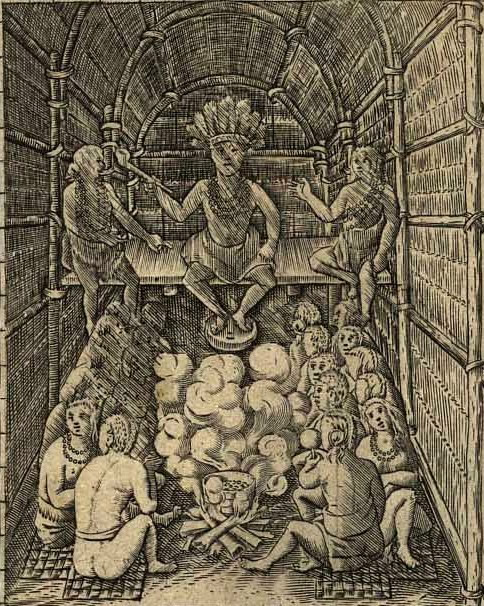The Powhatan Confederacy, which included approximately 30 different Algonquian-speaking tribes at the height of its power, developed on the Eastern Seaboard of North America in present-day Virginia.
Powhatan, who was the leader of this confederacy in the late 16th and early 17th centuries, maintained control from his main residence in Werowocomoco on the York River. Before the English settled at Jamestown in 1607, the Powhatan Confederacy was the strongest force in the area.
Powhatan kept control by marrying the daughters of defeated chiefdoms in an attempt to link their families to his family and appointing a family member to the position of chief. To minimize the risk of tribes within the confederacy combating one another, Powhatan organized a hunting expedition in the Piedmont to incite conflict against the Monacan and Manahoac tribes.
  |
Despite the fact that there was some degree of cooperation between the Powhatan and the English colonists, mutual suspicion destroyed the relationship between the two races. The English colonists thought very highly of Powhatan.
Despite the desire to use the English as allies, Powhatan was still suspicious of their intentions and attempted to contain their settlement; he was also concerned that the English might ally with his enemies. In order to contain the English settlement of Jamestown, Powhatan used the Paspahegh to create conflict with the English settlers.
The English soon adopted another policy to deal with the Powhatan—kidnap their children to force the Powhatan into a more subservient position. In 1613, the English captured Powhatan’s daughter Pocahontas and took her back to Jamestown, where she converted to Christianity and assumed the name Rebecca. Powhatan accepted the fact that the English had captured his daughter and tried to reach some peace settlement by offering her to the English.
The peace settlement Powhatan arranged with the colonists improved relations between the Powhatan and the English colonists. Pocahontas accepted the English way of life by dressing in European fashions, marrying an Englishman named John Rolfe in 1614, and giving birth to a child.
She left her father to travel to England, where she succumbed to disease in 1617. Her father died in 1618 and was replaced by his brother Opechancanough, who changed the dynamics in the relationship between the Powhatan and the English colonists.
The major point of contention between the Powhatan and the English arose over ownership of land as the English colonists needed a significant area of land to grow tobacco. The fact that more English colonists continued to arrive in Virginia strengthened the resolve of Opechancanough to strike at the English before their numbers became too great.
   |
The first major attack took place on March 22, 1622, and resulted in the death of approximately 347 colonists. The English retaliated by organizing offensives against Powhatan towns and destroying their crops before the harvesting period.
The Powhatan Confederacy, suffering from starvation, participated in peace negotiations with the English colonists. In 1623, at the closing stages of the peace talks, 250 natives met with the leaders of the English colony in what they believed was a cordial meeting, but the English poisoned the drinks of the natives and killed the delegation. This led to further reprisals by the Powhatan, who organized a massive offensive on April 18, 1644, which resulted in the deaths of more than 400 colonists.
At this point, it was a losing battle for the Powhatan as there were too many colonists for them to overcome. The resistance of the Powhatan to English imperialism sustained a further blow when Opechancanough was captured in 1646 by the English and shot by a disgruntled colonist while in prison.
The Powhatan Confederacy suffered greatly from English colonization, as frequent warfare and epidemics dropped the population from 24,000 Algonquians when the English settled Jamestown in 1607 to 2,000 Algonquians in 1669. The final dispersal for the Powhatan Confederacy occurred with the Treaty of Albany in 1722, which protected the Powhatan from Iroquois attacks, allowing the Powhatan to disperse into various groups.

